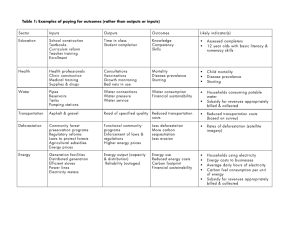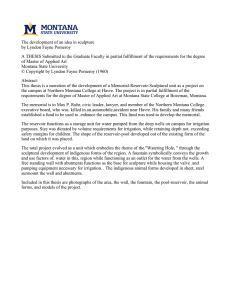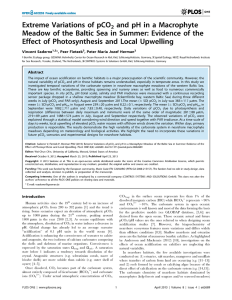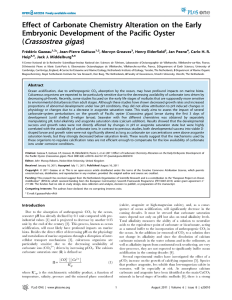COMPREHENSIVE AND EFFECTIVE RECORDING OF
advertisement
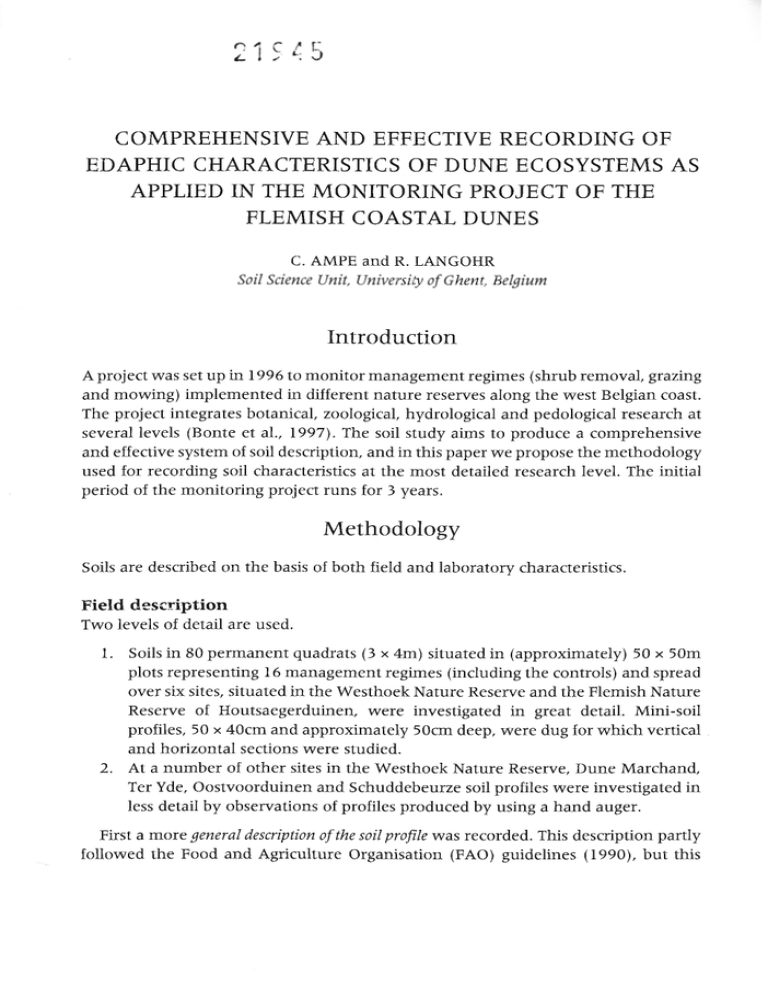
COMPREHENSIVE AND EFFECTIVE RECORDING OF
EDAPHIC CHARACTERISTICS OF DUNE ECOSYSTEMS AS
APPLIED IN THE MONITORING PROJECT OF THE
FLEMISH COASTAL DUNES
C. AMPE and R. LANGOHR
Soil
Science
Unit,
University
In tro d u ctio n
A project was set up in 1996 to m onitor m anagem ent regim es (shrub rem oval, grazing
and m ow ing) im plem ented in different n atu re reserves along the w est Belgian coast.
The project integrates botanical, zoological, hydrological and pedological research at
several levels (Bonte et al., 1997). The soil study aims to produce a com prehensive
and effective system of soil description, and in this paper w e propose the m ethodology
used for recording soil characteristics at the m ost detailed research level. The initial
period of th e m onitoring project runs for 3 years.
M ethodology
Soils are described on th e basis of bo th field and laboratory characteristics.
Field description
Two levels of detail are used.
1.
2.
Soils in 80 p erm a n en t quadrats (3 x 4m) situated in (approxim ately) 30 x 50m
plots representing 16 m anagem ent regimes (including the controls) and spread
over six sites, situated in the W esthoek N ature Reserve and the Flem ish N ature
Reserve of H outsaegerduinen, w ere investigated in great detail. M ini-soil
profiles, 50 x 40cm and approxim ately 50cm deep, w ere dug for w hich vertical
and horizontal sections w ere studied.
At a n u m b er of o ther sites in the W esthoek N ature Reserve, D une M archand,
Ter Yde, O ostvoorduinen and Schuddebeurze soil profiles w ere investigated in
less detail by observations of profiles produced by using a h an d auger.
First a m ore general description of the soil profile was recorded. This description partly
followed th e Food and A griculture O rganisation (FAO) guidelines (1990), b u t this
Recording Edaphic Characteristics in the Flemish Dunes
419
standard technique for soil profile description provides insufficient data for an u n d e r­
standing of the ecosystem dynam ics. Based on literature, m ainly from The N etherlands,
and personal experience w e added a nu m b er of param eters to be described.
D une soils are often shallow for root pen etratio n and the humus form will play a
very im portant role in increasing the available nutrients and m oisture for plant grow th.
The term inology according to G reen et al. (1993) was em ployed for the description
of th e h u m u s form. The param eters considered w ere horizon designation and depth,
m oisture status, colour, fabric including structure, texture and character, roots, soil
flora and fauna.
The thickness of the biological active layer ('bi' horizon), the sum of the horizons w here
the m ajority of th e roots are concentrated, is often lim ited in sandy dune soils. Form er
research along a topo-chronosequence in the W esthoek N ature Reserve has show n
th a t in hollows th e thickness of the biological active layer was often lim ited to about
20cm. This biological active layer was underlain by a m ore compact ('d') horizon w ith
alm ost no m ore roots. Bulk density m easurem ents resulted in the following values:
1.35 (n = 49), 1.50 (n = 121) and 1.56 (n = 436) g per cm 3 for the Abi, Bbi and Cd
horizons respectively. On the m icro-ridges the biological active layer becam e thicker,
often due to bioturbation caused, for exam ple, by rabbits, and rooting was m ore
developed in the resu ltant air spaces (Ampe and Langohr, 1993). The thickness of the
biological layer was m easured from the vertical section or determ ined w ith a p e n e ­
tratio n rod of surface area 1cm2.
The lim ited thickness of the biologically active layer has im portant consequences
for w ater and n u trien t supply. Firstly, the w ater available to plants in dune soils
am ounts to only a few per cent of the total am o u n t of w ater present and is only higher
in those surface horizons w ith som ew hat greater organic m atter (OM) content.
Secondly, if th e g roundw ater table is at a greater depth th a n th e sum of the th ick ­
nesses of th e biological active layer and the capillary rise, plants encounter great
problem s in w ater uptake. Due to a lim ited thickness of the biological active layer, the
system is very sensitive to disturbances.
In this study particular atten tio n was paid to rooting characteristics. Size (diam eter),
abundance, orientation and species are determ ined on the vertical as well as on the
horizontal section. In some profiles live roots w ere observed growing in old hum ified
root galleries. It can be deduced th at on the one h an d we have plants w hich grow
w ith the accreting dune such as Ammophila arenaria and Salix repens, and on the other
h an d th ere are plant species w hich m ake use of the presence of these old hum ified
root galleries in later successional stages. If these old root galleries are missing, fu rth er
colonization of th e dune will be very slow.
Specific rooting characteristics of different plant species have also been investigated
as these m ay explain w hy some plant species are m ore com petitive th a n others in
their struggle for w ater and n u trie n t supply.
Extent of décalcification is determ ined w ith HCl (2N). Décalcification can vary w ithin
the profile due to:
420
•
•
•
•
M ONITO RIN G : M ETHODS AND APPLICATIONS
th e presence of buried decalcified hum ic horizons;
the active process of deposition w hereby the soil isregularly show ered w ith
fresh calcareous sand;
lateral supply w ith calcareous seepage water;
tu rb atio n activity by anim als (rabbits, moles, mice) or people (forest m an ag e­
m ent, thinning).
The pattern of décalcification can also be very irregular over short distances in space,
resulting in a m osaic of caldcóle and calcifuge vegetation.
The soil is tested for water repellency u n d er field conditions and also on air-dry samples
in th e laboratory. Soils w hich are w ater repellent show a certain resistance to w ater
penetration, a com m on characteristic of dune soils (Dekker and Jungerius, 1990). The
m odel of hom ogeneous w etting fronts cannot be applied in such soils. Preferential
flows develop in tongues or fingers along roots, in m icrodepressions or less repellent
areas, or follow buried horizons. Along these preferential flow routes w ater can reach
th e g ro u n d w ater table m u ch faster th a n w ould norm ally be expected. In the field,
patches of m oist soil surrounded by com pletely dry patches can be observed. W ater
repellency is therefore an o th er factor causing dune soils to be drier th a n expected.
Oxidation-reduction features w ere described. A bundance, size, contrast, boundary,
colour, th e activity status and the related distribution of the m ottling w ere recorded.
Active m ottling can be represented by the presence of a rusty rim especially along
Carex roots. On the horizontal section, sharp concentric rust-coloured m ottling
surrounding a live root can be seen; on the vertical section this kind of m ottling forms
rusty vertical streaks along the root. U -shaped m ottles can very clearly be seen on
horizontal sections, th eir m orphology consisting of a dark, som etim es black nucleus
- a dead root channel - surrounded by the U -shaped rusty colouring. Indeed, due to
lateral w ater flow th e original concentric m ottle becom es U -shaped w ith the closed
end show ing th e direction from w here the w ater flow comes. A part from these very
striking types of m ottling, a rust-coloured soil m atrix can be observed in som e horizons.
Other special features can be observed on the vertical and horizontal sections. Plough
layers or th in bands th at are probably buried algal bands are exam ples of such features.
Sampling strategy
Siting of th e mini-profile and sam pling took place on one of the four sides of the
p erm an en t quadrat w ith a preference for the southern. In the m ini-profile bulk samples
w ere tak en for each horizon. For som e representative horizons undisturbed samples
(5 replicates of cores of 100cm 3) w ere taken on the horizontal section for bulk density
determ ination.
For th e surface mineral horizon betw een 0-5 and 0 -1 0cm, a com posite sam ple was
tak en consisting of 5 subsam ples. Because of persisting dry conditions of th e soil or
th e presence of thick roots (Salix repens) or rhizom es (Iris pseudacorus), n eith er the
gouge auger n o r the grass plot sam pler (a small auger designed for grass-covered
Recording Edaphic Characteristics in the Flemish Dunes
421
terrain, pressed into the soil by stepping on the container w hich subsequently collects
the sample) proved to be practical. Therefore rings w ith a height of 5 and 10cm w ere
used to sample the soil.
The humus profile was sam pled at some selected sites. For this a stainless steel cylinder
w ith a diam eter of 25cm and a height of 20cm was ham m ered into the soil. The L, F,
H and A horizons w ere tak en off separately and placed in bags. For each p erm an en t
quadrat this sam pling was repeated three times.
Laboratory analysis
The following analyses are provisionally being considered as appropriate.
M ain horizons: colour, w ater repellency, bulk density, pH H 2 O, pH KCl, CaCCb,
organic carbon.
Samples betw een 0-5 and 0 -1 0cm depth based on m ixed sampling: w ater repel­
lency, pH H 2 O, pH KCl, CaCCb, organic carbon, N, Cation Exchange Capacity.
Samples of th e h u m us profile: air dry weight, pH H 2 O, pH KCl, organic carbon
and N.
Acknow ledgm ents
This research is co-financed by th e LIFE n atu re project ICCI.
References
A m pe, C. and Langohr, R. (1993), 'Distribution and dynamics of shrub roots in recent coastal
dune valley ecosystems of Belgium', Geodermar 56, 37-55.
B onte, D., A m p e, C., H offm ann, M., Langohr, R., Provoost, S. and Herrier, J.L. (1997),
'Monitoring research in the Flemish dunes: from a descriptive to an integrated approach', in
C.H. Ovesen (ed.), Coastal Dunes-Management, Protection and Research, report from a European
seminar, Skagen, Denmark, August 1997. National Forest and Nature Agency, Geological
Survey of Denmark and Greenland.
D ekker, L.W. and Jungerius, P.D. (1990), 'W ater repellency in the dunes with special
reference to The Netherlands', Catena Supplement, 18, 173-83.
Food and A griculture O rganisation (1990), Guidelines for Profile Description, 3rd edn, Food
and Agriculture Organisation, Rome.
Green, R.N., Trowbridge, R.L. and K linka, K. (1993), Towards a Taxonomic Classification of
Humus Forms, Forest Science, M onograph 29, Society of American Foresters, Bethesda, MD.
